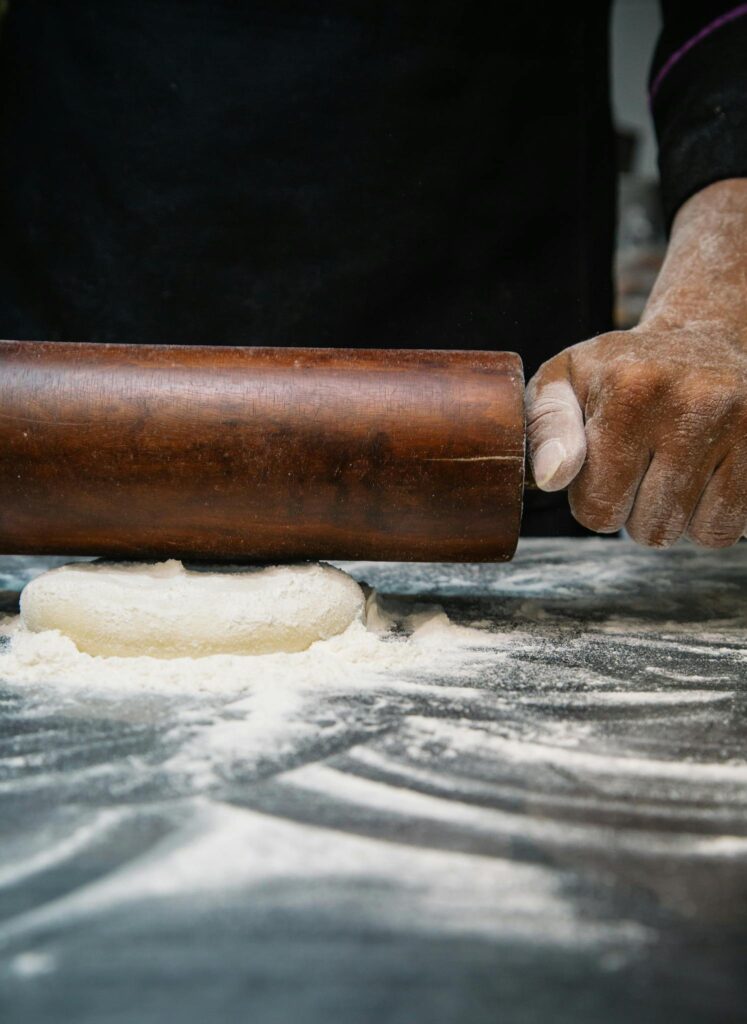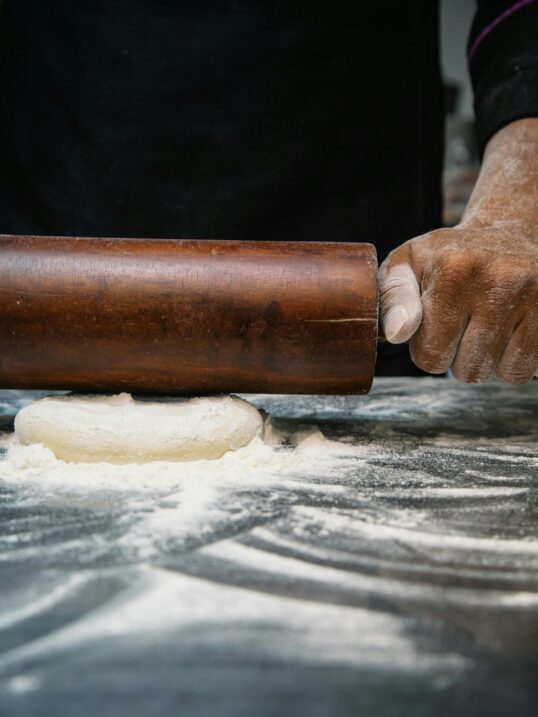When browsing the baking aisle, you’ve likely noticed both bleached and unbleached flour options sitting side by side. While they may look similar, these two flour varieties have distinct differences that can impact your baking results.
This comprehensive guide explores what sets bleached and unbleached flour apart and helps you decide which is best for your specific baking needs.
What Is Bleached Flour?
Bleached flour has been chemically treated to speed up the aging process. Freshly milled flour naturally whitens and improves its baking qualities as it ages through oxidation.
Chemical bleaching accelerates this process, taking just days rather than the weeks or months required for natural aging.
Common bleaching agents include:
- Benzoyl peroxide
- Chlorine gas
- Chlorine dioxide
- Calcium peroxide
- Azodicarbonamide
These chemicals break down the flour’s yellow pigments (carotenoids) and alter its protein structure, resulting in a softer, whiter flour with a finer grain.
What Is Unbleached Flour?
Unbleached flour is flour that has been allowed to naturally age and whiten over time without chemical treatments. This natural oxidation process typically takes 1-2 months.
Unbleached flour retains more of its natural color, resulting in a slightly off-white or cream-colored product.
Differences Between Bleached vs Unbleached Flour
While there are some similarities, there are distinct differences between bleached and unbleached flour.
1. Appearance and Texture
Bleached flour boasts a pristine white color that many bakers find visually appealing, especially for wedding cakes and other elegant baked goods where appearance matters.
The bleaching process breaks down the flour’s proteins, producing a noticeably finer, softer texture that feels silky to the touch. This refined texture contributes to the delicate crumb structure in cakes and pastries.
Unbleached flour, by contrast, has a natural cream or off-white color with subtle yellow undertones from the carotenoid pigments that remain intact. Its texture is slightly more robust and coarser, as the proteins haven’t been chemically altered. When rubbed between your fingers, unbleached flour feels a bit more substantial, which translates to greater strength in dough formation.
2. Baking Performance
The performance differences between these flours become most apparent in the finished baked goods. Bleached flour excels at producing light, airy cakes with tender crumbs. The modified protein structure allows batters to rise more effectively while maintaining a delicate texture. Cookies made with bleached flour tend to spread more during baking, creating thinner, crisper results. The flour’s ability to form weaker gluten bonds makes it ideal for tender baked goods where minimal chewiness is desired.
Unbleached flour’s higher protein integrity creates stronger gluten development, making it the preferred choice for yeast breads and pizza doughs where chewiness and structure are prized attributes. The stronger gluten network captures gases produced during fermentation more effectively, resulting in better oven spring and more defined texture in artisanal breads. Pastries made with unbleached flour typically have more distinct, flaky layers due to the flour’s ability to form stronger sheets when laminated with fat.
3. Nutritional Value
From a nutritional standpoint, the differences between bleached and unbleached flour are subtle but noteworthy. The bleaching process diminishes natural vitamin E content and destroys some carotenoids that function as antioxidants in the body. While both flour types undergo enrichment with B vitamins and iron as mandated by law, unbleached flour retains slightly more of its native nutrients.
Unbleached flour preserves more of wheat’s natural flavor compounds, which can contribute subtle nutty or sweet notes to baked goods. This flavor difference is most noticeable in simple preparations like pie crusts or biscuits where flour is a dominant ingredient. Professional bakers sometimes prefer unbleached flour for this reason, finding that it adds complexity to the flavor profile of their creations.
4. Shelf Life
The chemical treatments applied to bleached flour have the secondary benefit of extending its shelf life considerably. By neutralizing fats that can go rancid and eliminating enzyme activity, bleached flour typically remains usable for up to two years when stored properly in a cool, dry place in an airtight container.
Unbleached flour contains more natural oils and active enzymes, making it more susceptible to spoilage over time. Its typical shelf life ranges from six months to a year under ideal storage conditions. Bakers who don’t use flour frequently might prefer bleached flour for its longevity, while those who value freshness and bake regularly might not find the shorter shelf life of unbleached flour to be a significant drawback.
Choosing the Bleached vs Unbleached Flour for Your Baking Needs
Selecting the ideal flour type depends on several factors, including your specific recipe, desired outcome, and personal preferences. Here’s a practical guide to help you make the best choice for various baking scenarios:
Consider Your Recipe Type
The nature of what you’re baking should be your primary consideration when choosing between bleached and unbleached flour:
For delicate, tender baked goods like angel food cake, layer cakes, and soft cookies, bleached flour’s finer texture and lower protein content will produce superior results. The chemical treatment weakens the proteins, resulting in less gluten formation and a more delicate final product.
For rustic, chewy items such as artisanal bread, pizza dough, and bagels, unbleached flour’s stronger protein structure creates the ideal foundation. The robust gluten network provides the necessary structure for proper rising and that desirable chewy texture.
Factor in Your Baking Experience Level
Your comfort level with baking can also influence your flour choice:
Novice bakers might find bleached flour more forgiving for general baking. Its consistent performance and predictable results make it an excellent starting point for those developing their skills. Cakes and cookies made with bleached flour are less likely to become tough from overmixing.
Experienced bakers often prefer unbleached flour for its subtle flavor advantages and versatility. With practice, they’ve learned how to control gluten development through proper handling techniques, allowing them to achieve optimal results even in delicate baked goods.
When to Use Each Type
Best Uses for Bleached Flour:
- Angel food cake
- White cake
- Biscuits
- Scones
- Pancakes
- Quick breads
- Sugar cookies
- Pie crusts (for more tender results)
Best Uses for Unbleached Flour:
- Bread
- Pizza dough
- Bagels
- Pretzels
- Croissants
- Puff pastry
- Sturdy cookies
- Pie crusts (for flakier results)
Health and Environmental Considerations
Some bakers prefer unbleached flour due to concerns about chemical residues from the bleaching process. While the FDA has approved all bleaching agents currently used in the United States as safe for consumption, some countries have banned certain bleaching chemicals like potassium bromate and azodicarbonamide due to potential health concerns.
Environmentally conscious bakers may prefer unbleached flour due to the reduced chemical processing involved in its production.
Popular Flour Brands and Options
Many major flour brands offer both bleached and unbleached options:
- King Arthur Flour (primarily offers unbleached)
- Gold Medal
- Pillsbury
- Bob’s Red Mill
- White Lily (popular for bleached all-purpose and self-rising flour)
- Hodgson Mill
Frequently Asked Questions
Can You Substitute Bleached for Unbleached—And Vice Versa?
Yes, in many recipes, bleached and unbleached flour can be substituted for each other with relatively minor differences in the final result. For everyday baking like cookies, muffins, and basic breads, most home bakers won’t notice a significant difference. However, there are some considerations to keep in mind:
When substituting bleached flour for unbleached:
- Your baked goods may have slightly less structure and could be more tender
- Bread might not rise quite as high or have the same chewy texture
- The color of your baked goods will be slightly whiter
When substituting unbleached flour for bleached:
- Cakes might be slightly less tender and a bit more dense
- Cookies could spread less during baking
- The finished product may have a slightly cream-colored hue
For specialty baking where texture is crucial—like angel food cake or artisanal bread—using the specified type of flour will yield the best results.
Does Bleached Flour Taste Different Than Unbleached?
Most people cannot detect a significant taste difference in the finished baked goods. Unbleached flour has a slightly more wheat-like flavor that some discerning palates might notice, especially in recipes where flour is the dominant ingredient. Bleached flour has a more neutral flavor profile.
Is Unbleached Flour Healthier Than Bleached Flour?
Unbleached flour retains slightly more natural nutrients, particularly vitamin E and certain antioxidants. However, since both types are typically enriched with vitamins and minerals, the nutritional differences are minimal from a macronutrient perspective. Those concerned about chemical processing may prefer unbleached flour for its more natural state.
Why Do Some Countries Ban Bleached Flour?
Several countries, including those in the European Union, have banned chemically bleached flour due to concerns about certain bleaching agents and a general preference for less processed foods. Some bleaching agents like potassium bromate and azodicarbonamide have been linked to potential health concerns in animal studies, leading to their prohibition in these regions.
How Can I Tell If My Flour Is Bleached or Unbleached?
Check the packaging label, which should clearly state whether the flour is bleached or unbleached. If it doesn’t specify, you can often tell by the color—bleached flour is bright white, while unbleached flour has a cream or off-white color with a slightly denser texture.
Does Bleached or Unbleached Flour Affect Gluten Development?
Yes. Unbleached flour typically develops stronger gluten bonds due to its intact protein structure. This makes it ideal for bread and other baked goods that benefit from structure and chewiness. Bleached flour forms weaker gluten bonds, resulting in more tender baked goods.
Conclusion
The choice between bleached and unbleached flour ultimately comes down to your specific baking needs and personal preferences. For delicate baked goods with a tender crumb, bleached flour often provides superior results. For rustic breads and products where chewiness is desired, unbleached flour is typically the better choice.
Experiment with both types to discover which you prefer for your favorite recipes. Many professional bakers keep both varieties on hand, selecting the appropriate flour based on what they’re making. Whichever you choose, proper storage in an airtight container in a cool, dry place will help maintain freshness and quality.




Leave a Reply